Abstract
To quantify the impact of chronic exposure to neuroleptic medication on the occurrence of tardive dyskinesia (TD), we conducted a meta-analysis of data collected from 21 studies published between 1966 and 1985. The observed prevalence of dyskinesia was greater among exposed subjects in all 21 studies; we estimate that, on the average, the occurrence rate was 2.9 times greater in exposed persons than would be expected if they had been unexposed. We estimate that 65 per cent of exposed cases and 51 per cent of all cases in these investigations were caused by long-term neuroleptic exposure. Among adult United States residents in 1980, we estimate that there were approximately 193,000 neuroleptic-induced TD cases of which about 60 per cent occurred in outpatients. We also observed substantial heterogeneity of effect (rate ratio) across studies, however, partially explained, by changes and differences in the rate of dyskinesia, by differences in the frequency of certain effect modifiers, and by differences in diagnostic methods. Methodologic limitations of the studies and their possible effects on our results are discussed.
Full text
PDF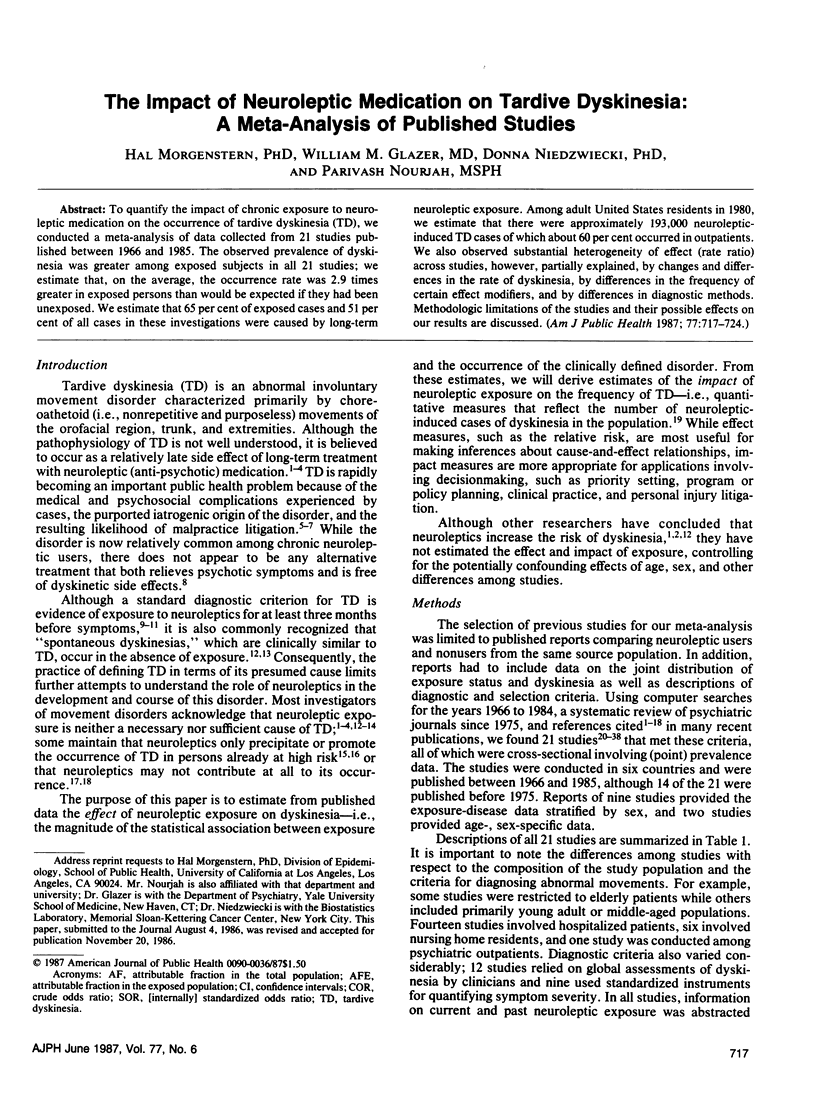
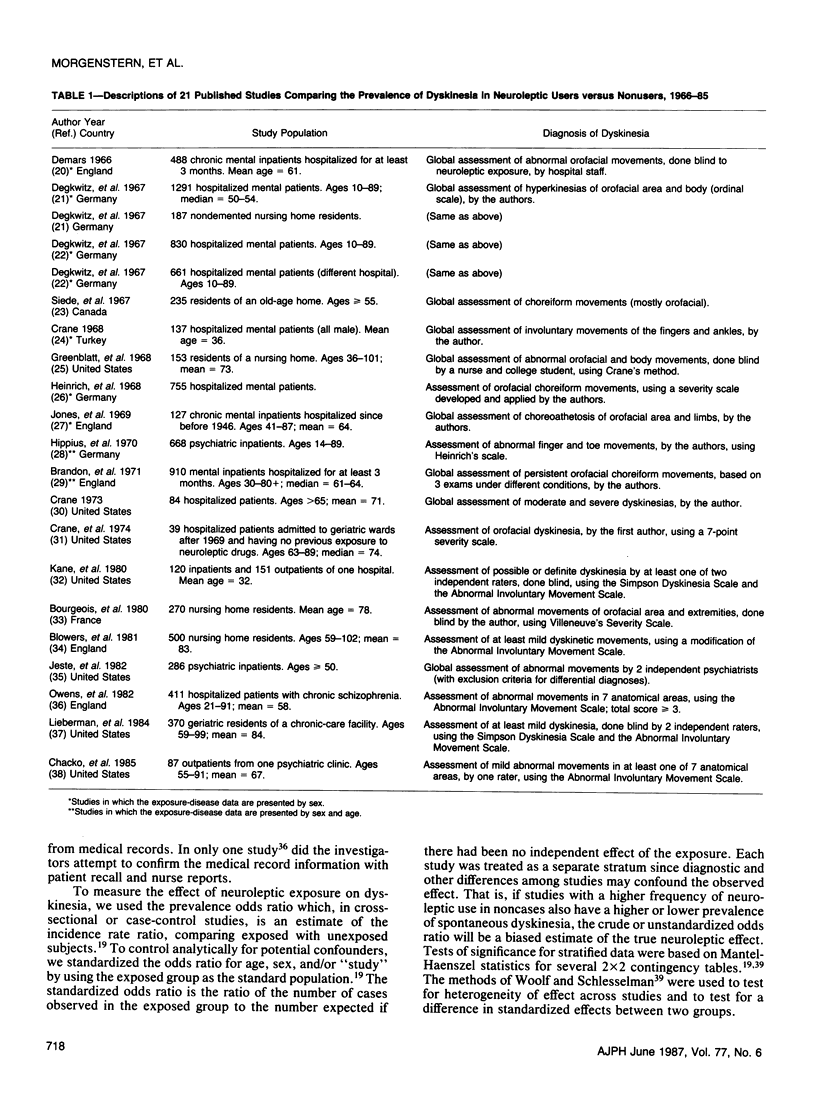
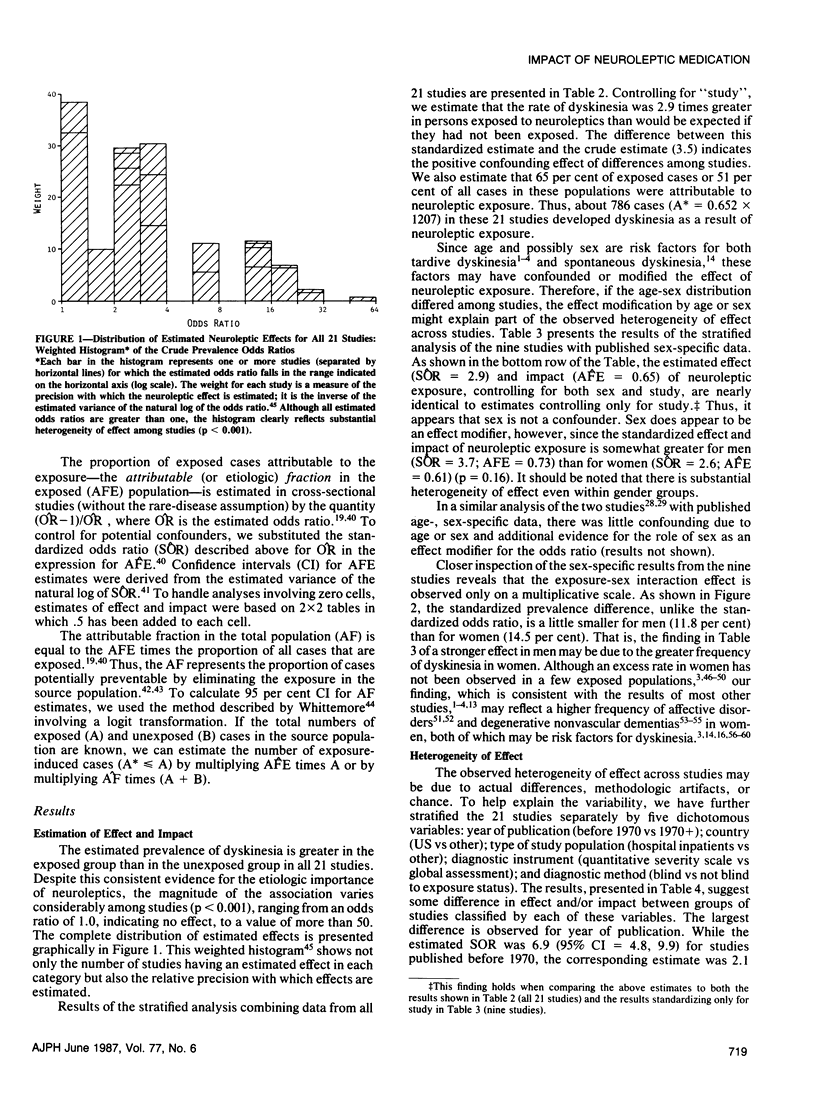
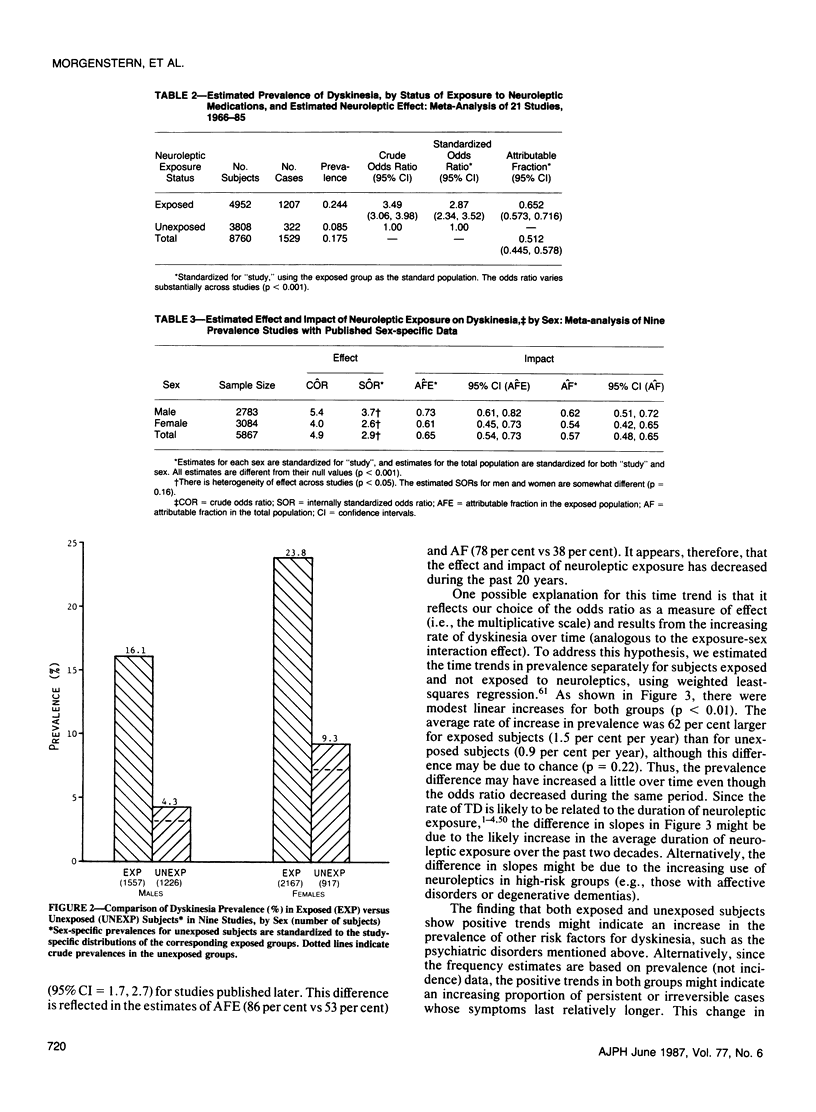
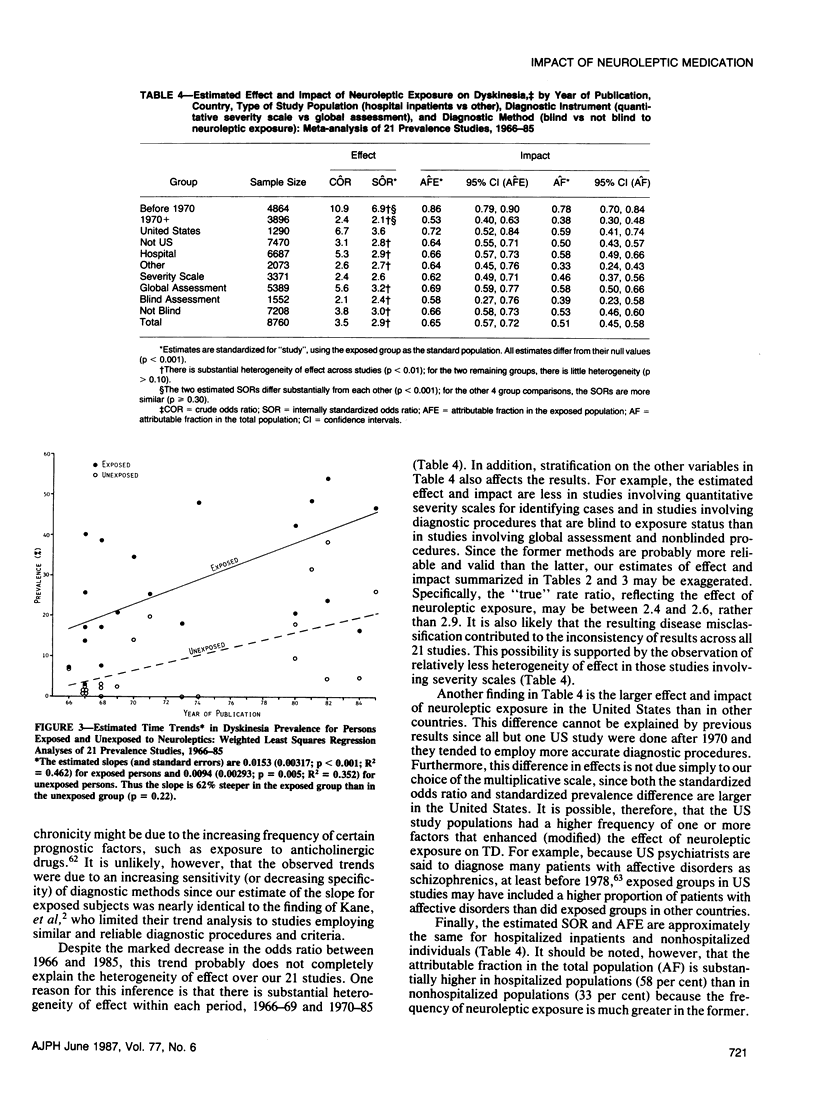
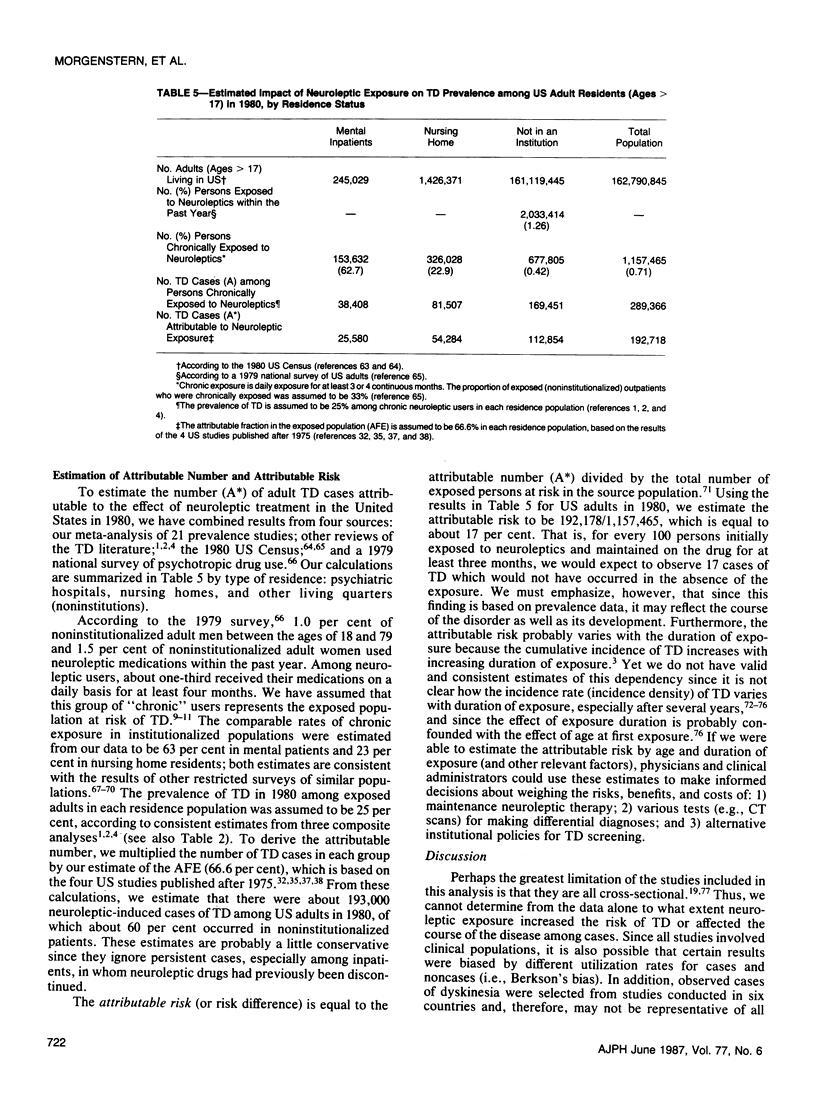
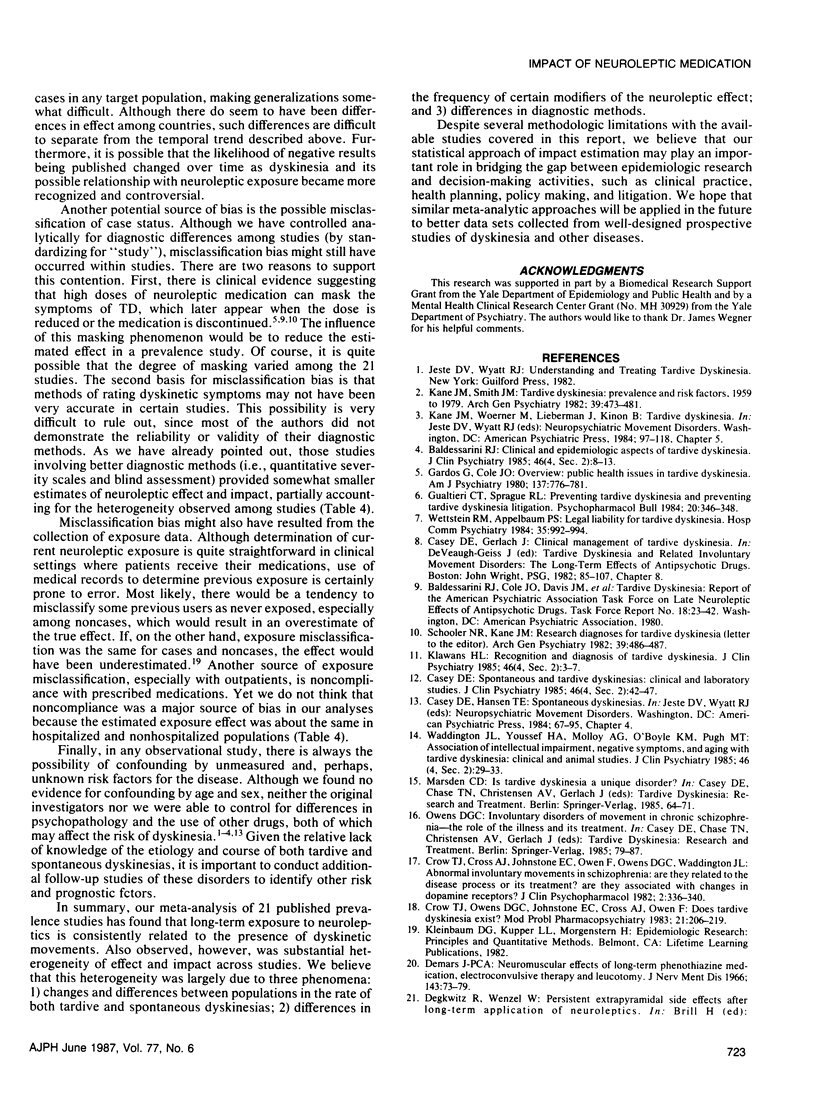
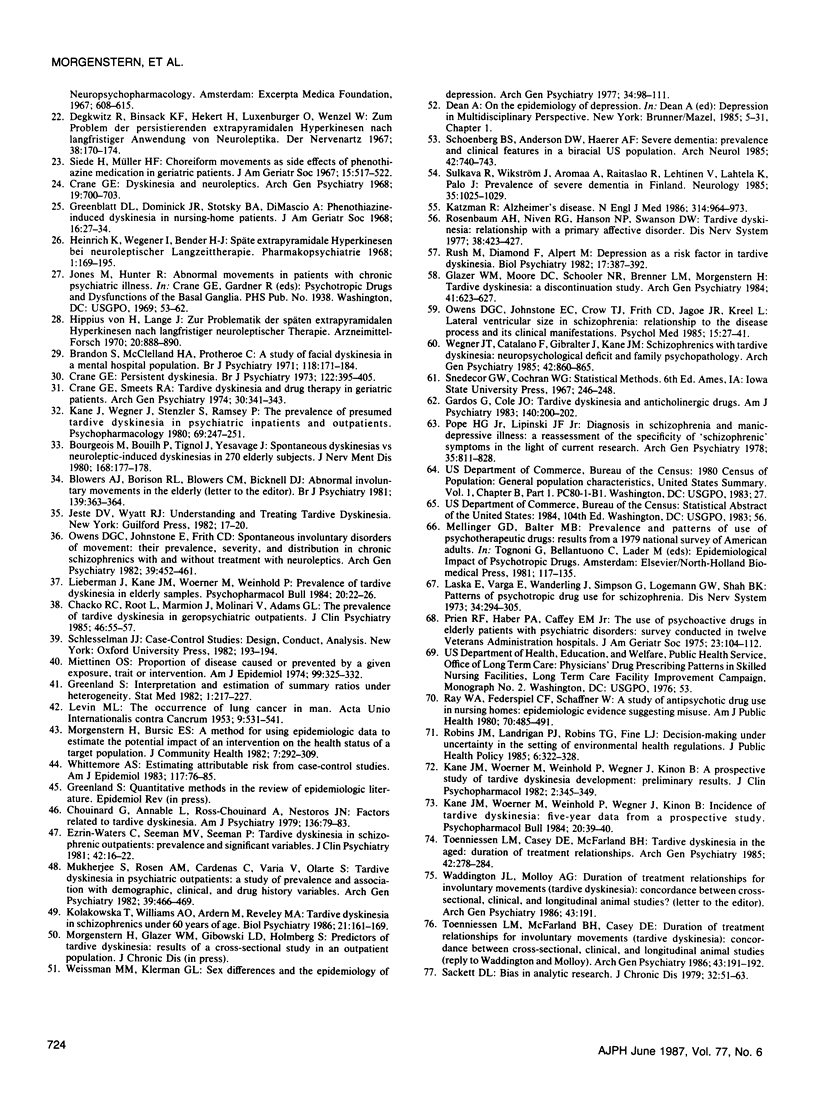
Selected References
These references are in PubMed. This may not be the complete list of references from this article.
- Baldessarini R. J. Clinical and epidemiologic aspects of tardive dyskinesia. J Clin Psychiatry. 1985 Apr;46(4 Pt 2):8–13. [PubMed] [Google Scholar]
- Blowers A. J., Borison R. L., Blowers C. M., Bicknell D. J. Abnormal involuntary movements in the elderly. Br J Psychiatry. 1981 Oct;139:363–364. [PubMed] [Google Scholar]
- Bourgeois M., Bouilh P., Tignol J., Yesavage J. Spontaneous dyskinesias vs. neuroleptic-induced dyskinesias in 270 elderly subjects. J Nerv Ment Dis. 1980 Mar;168(3):177–178. doi: 10.1097/00005053-198003000-00009. [DOI] [PubMed] [Google Scholar]
- Brandon S., McClelland H. A., Protheroe C. A study of facial dyskinesia in a mental hospital population. Br J Psychiatry. 1971 Feb;118(543):171–184. doi: 10.1192/bjp.118.543.171. [DOI] [PubMed] [Google Scholar]
- Casey D. E. Spontaneous and tardive dyskinesias: clinical and laboratory studies. J Clin Psychiatry. 1985 Apr;46(4 Pt 2):42–47. [PubMed] [Google Scholar]
- Chacko R. C., Root L., Marmion J., Molinari V., Adams G. L. The prevalence of tardive dyskinesia in geropsychiatric outpatients. J Clin Psychiatry. 1985 Feb;46(2):55–57. [PubMed] [Google Scholar]
- Chouinard G., Annable L., Ross-Chouinard A., Nestoros J. N. Factors related to tardive dyskinesia. Am J Psychiatry. 1979 Jan;136(1):79–82. doi: 10.1176/ajp.136.1.79. [DOI] [PubMed] [Google Scholar]
- Crane G. E. Dyskinesia and neuroleptics. Arch Gen Psychiatry. 1968 Dec;19(6):700–703. doi: 10.1001/archpsyc.1968.01740120060009. [DOI] [PubMed] [Google Scholar]
- Crane G. E. Persistent dyskinesia. Br J Psychiatry. 1973 Apr;122(569):395–405. doi: 10.1192/bjp.122.4.395. [DOI] [PubMed] [Google Scholar]
- Crane G. E., Smeets R. A. Tardive dyskinesia and drug therapy in geriatric patients. Arch Gen Psychiatry. 1974 Mar;30(3):341–343. doi: 10.1001/archpsyc.1974.01760090055009. [DOI] [PubMed] [Google Scholar]
- Crow T. J., Cross A. J., Johnstone E. C., Owen F., Owens D. G., Waddington J. L. Abnormal involuntary movements in schizophrenia: are they related to the disease process or its treatment? Are they associated with changes in dopamine receptors? J Clin Psychopharmacol. 1982 Oct;2(5):336–340. [PubMed] [Google Scholar]
- Crow T. J., Owens D. G., Johnstone E. C., Cross A. J., Owen F. Does tardive dyskinesia exist? Mod Probl Pharmacopsychiatry. 1983;21:206–219. doi: 10.1159/000408495. [DOI] [PubMed] [Google Scholar]
- Degkwitz R., Binsack K. F., Herkert H., Luxenburger O., Wenzel W. Zum Problem der persistierenden extrapyramidalen Hyperkinesen nach langfristiger Anwendung von Neuroleptika. Nervenarzt. 1967 Apr;38(4):170–174. [PubMed] [Google Scholar]
- Demars J. P. Neuromuscular effects of long-term phenothiazine medication, electroconvulsive therapy and leucotomy. J Nerv Ment Dis. 1966 Jul;143(1):73–79. doi: 10.1097/00005053-196607000-00008. [DOI] [PubMed] [Google Scholar]
- Ezrin-Waters C., Seeman M. V., Seeman P. Tardive dyskinesia in schizophrenic outpatients: prevalence and significant variables. J Clin Psychiatry. 1981 Jan;42(1):16–22. [PubMed] [Google Scholar]
- Gardos G., Cole J. O. Overview: public health issues in tardive dyskinesia. Am J Psychiatry. 1980 Jul;137(7):776–781. doi: 10.1176/ajp.137.7.776. [DOI] [PubMed] [Google Scholar]
- Gardos G., Cole J. O. Tardive dyskinesia and anticholinergic drugs. Am J Psychiatry. 1983 Feb;140(2):200–202. doi: 10.1176/ajp.140.2.200. [DOI] [PubMed] [Google Scholar]
- Glazer W. M., Moore D. C., Schooler N. R., Brenner L. M., Morgenstern H. Tardive dyskinesia. A discontinuation study. Arch Gen Psychiatry. 1984 Jun;41(6):623–627. doi: 10.1001/archpsyc.1984.01790170097011. [DOI] [PubMed] [Google Scholar]
- Greenblatt D. L., Dominick J. R., Stotsky B. A., DiMascio A. Phenothiazine-induced dyskinesia in nursing-home patients. J Am Geriatr Soc. 1968 Jan;16(1):27–34. doi: 10.1111/j.1532-5415.1968.tb03966.x. [DOI] [PubMed] [Google Scholar]
- Greenland S. Interpretation and estimation of summary ratios under heterogeneity. Stat Med. 1982 Jul-Sep;1(3):217–227. doi: 10.1002/sim.4780010304. [DOI] [PubMed] [Google Scholar]
- Gualtieri C. T., Sprague R. L. Preventing tardive dyskinesia and preventing tardive dyskinesia litigation. Psychopharmacol Bull. 1984 Summer;20(3):346–348. [PubMed] [Google Scholar]
- Hippius H., Lange J. Zur Problematik der späten extrapyramidalen Hyperkinesen nach langfristiger neuroleptischer Therapie. Arzneimittelforschung. 1970 Jul;20(7):888–890. [PubMed] [Google Scholar]
- Kane J. M., Smith J. M. Tardive dyskinesia: prevalence and risk factors, 1959 to 1979. Arch Gen Psychiatry. 1982 Apr;39(4):473–481. doi: 10.1001/archpsyc.1982.04290040069010. [DOI] [PubMed] [Google Scholar]
- Kane J. M., Woerner M., Weinhold P., Wegner J., Kinon B. A prospective study of tardive dyskinesia development: preliminary results. J Clin Psychopharmacol. 1982 Oct;2(5):345–349. [PubMed] [Google Scholar]
- Kane J. M., Woerner M., Weinhold P., Wegner J., Kinon B. Incidence of tardive dyskinesia: five-year data from a prospective study. Psychopharmacol Bull. 1984 Winter;20(1):39–40. [PubMed] [Google Scholar]
- Kane J., Wegner J., Stenzler S., Ramsey P. The prevalence of presumed tardive dyskinesia in psychiatric inpatients and outpatients. Psychopharmacology (Berl) 1980;69(3):247–251. doi: 10.1007/BF00433090. [DOI] [PubMed] [Google Scholar]
- Katzman R. Alzheimer's disease. N Engl J Med. 1986 Apr 10;314(15):964–973. doi: 10.1056/NEJM198604103141506. [DOI] [PubMed] [Google Scholar]
- Klawans H. L. Recognition and diagnosis of tardive dyskinesia. J Clin Psychiatry. 1985 Apr;46(4 Pt 2):3–7. [PubMed] [Google Scholar]
- Kolakowska T., Williams A. O., Ardern M., Reveley M. A. Tardive dyskinesia in schizophrenics under 60 years of age. Biol Psychiatry. 1986 Feb;21(2):161–169. doi: 10.1016/0006-3223(86)90143-5. [DOI] [PubMed] [Google Scholar]
- LEVIN M. L. The occurrence of lung cancer in man. Acta Unio Int Contra Cancrum. 1953;9(3):531–541. [PubMed] [Google Scholar]
- Laska E., Varga E., Wanderling J., Simpson G., Logemann G. W., Shah B. K. Patterns of psychotropic drug use for schizophrenia. Dis Nerv Syst. 1973 Aug-Sep;34(6):294–305. [PubMed] [Google Scholar]
- Lieberman J., Kane J. M., Woerner M., Weinhold P. Prevalence of tardive dyskinesia in elderly samples. Psychopharmacol Bull. 1984 Winter;20(1):22–26. [PubMed] [Google Scholar]
- Miettinen O. S. Proportion of disease caused or prevented by a given exposure, trait or intervention. Am J Epidemiol. 1974 May;99(5):325–332. doi: 10.1093/oxfordjournals.aje.a121617. [DOI] [PubMed] [Google Scholar]
- Morgenstern H., Bursic E. S. A method for using epidemiologic data to estimate the potential impact of an intervention on the health status of a target population. J Community Health. 1982 Summer;7(4):292–309. doi: 10.1007/BF01318961. [DOI] [PubMed] [Google Scholar]
- Mukherjee S., Rosen A. M., Cardenas C., Varia V., Olarte S. Tardive dyskinesia in psychiatric outpatients: a study of prevalence and association with demographic, clinical, and drug history variables. Arch Gen Psychiatry. 1982 Apr;39(4):466–469. doi: 10.1001/archpsyc.1982.04290040064009. [DOI] [PubMed] [Google Scholar]
- Owens D. G. Involuntary disorders of movement in chronic schizophrenia--the role of the illness and its treatment. Psychopharmacology Suppl. 1985;2:79–87. doi: 10.1007/978-3-642-70140-5_10. [DOI] [PubMed] [Google Scholar]
- Owens D. G., Johnstone E. C., Crow T. J., Frith C. D., Jagoe J. R., Kreel L. Lateral ventricular size in schizophrenia: relationship to the disease process and its clinical manifestations. Psychol Med. 1985 Feb;15(1):27–41. doi: 10.1017/s0033291700020900. [DOI] [PubMed] [Google Scholar]
- Owens D. G., Johnstone E. C., Frith C. D. Spontaneous involuntary disorders of movement: their prevalence, severity, and distribution in chronic schizophrenics with and without treatment with neuroleptics. Arch Gen Psychiatry. 1982 Apr;39(4):452–461. doi: 10.1001/archpsyc.1982.04290040052008. [DOI] [PubMed] [Google Scholar]
- Pope H. G., Jr, Lipinski J. F., Jr Diagnosis in schizophrenia and manic-depressive illness: a reassessment of the specificity of 'schizophrenic' symptoms in the light of current research. Arch Gen Psychiatry. 1978 Jul;35(7):811–828. doi: 10.1001/archpsyc.1978.01770310017001. [DOI] [PubMed] [Google Scholar]
- Prien R. F., Haber P. A., Caffey E. M., Jr The use of psychoactive drugs in elderly patients with psychiatric disorders: survey conducted in twelve Veterans Administration hospitals. J Am Geriatr Soc. 1975 Mar;23(3):104–112. doi: 10.1111/j.1532-5415.1975.tb00969.x. [DOI] [PubMed] [Google Scholar]
- Ray W. A., Federspiel C. F., Schaffner W. A study of antipsychotic drug use in nursing homes: epidemiologic evidence suggesting misuse. Am J Public Health. 1980 May;70(5):485–491. doi: 10.2105/ajph.70.5.485. [DOI] [PMC free article] [PubMed] [Google Scholar]
- Robins J. M., Landrigan P. J., Robins T. G., Fine L. J. Decision-making under uncertainty in the setting of environmental health regulations. J Public Health Policy. 1985 Sep;6(3):322–328. [PubMed] [Google Scholar]
- Rosenbaum A. H., Niven R. G., Hanson N. P., Swanson D. W. Tardive dyskinesia: relationship with a primary affective disorder. Dis Nerv Syst. 1977 Jun;38(6):423–427. [PubMed] [Google Scholar]
- Rush M., Diamond F., Alpert M. Depression as a risk factor in tardive dyskinesia. Biol Psychiatry. 1982 Mar;17(3):387–392. [PubMed] [Google Scholar]
- Sackett D. L. Bias in analytic research. J Chronic Dis. 1979;32(1-2):51–63. doi: 10.1016/0021-9681(79)90012-2. [DOI] [PubMed] [Google Scholar]
- Schoenberg B. S., Anderson D. W., Haerer A. F. Severe dementia. Prevalence and clinical features in a biracial US population. Arch Neurol. 1985 Aug;42(8):740–743. doi: 10.1001/archneur.1985.04210090004002. [DOI] [PubMed] [Google Scholar]
- Schooler N. R., Kane J. M. Research diagnoses for tardive dyskinesia. Arch Gen Psychiatry. 1982 Apr;39(4):486–487. doi: 10.1001/archpsyc.1982.04290040080014. [DOI] [PubMed] [Google Scholar]
- Siede H., Müller H. F. Choreiform movements as side effects of phenothiazine medication in geriatric patients. J Am Geriatr Soc. 1967 Jun;15(6):517–522. doi: 10.1111/j.1532-5415.1967.tb01191.x. [DOI] [PubMed] [Google Scholar]
- Sulkava R., Wikström J., Aromaa A., Raitasalo R., Lehtinen V., Lahtela K., Palo J. Prevalence of severe dementia in Finland. Neurology. 1985 Jul;35(7):1025–1029. doi: 10.1212/wnl.35.7.1025. [DOI] [PubMed] [Google Scholar]
- Toenniessen L. M., Casey D. E., McFarland B. H. Tardive dyskinesia in the aged. Duration of treatment relationships. Arch Gen Psychiatry. 1985 Mar;42(3):278–284. doi: 10.1001/archpsyc.1985.01790260072009. [DOI] [PubMed] [Google Scholar]
- Waddington J. L., Molloy A. G. Duration of treatment relationships for involuntary movements (tardive dyskinesia): concordance between cross-sectional, clinical, and longitudinal animal studies? Arch Gen Psychiatry. 1986 Feb;43(2):191–192. doi: 10.1001/archpsyc.1986.01800020101018. [DOI] [PubMed] [Google Scholar]
- Waddington J. L., Molloy A. G. Duration of treatment relationships for involuntary movements (tardive dyskinesia): concordance between cross-sectional, clinical, and longitudinal animal studies? Arch Gen Psychiatry. 1986 Feb;43(2):191–192. doi: 10.1001/archpsyc.1986.01800020101018. [DOI] [PubMed] [Google Scholar]
- Waddington J. L., Youssef H. A., Molloy A. G., O'Boyle K. M., Pugh M. T. Association of intellectual impairment, negative symptoms, and aging with tardive dyskinesia: clinical and animal studies. J Clin Psychiatry. 1985 Apr;46(4 Pt 2):29–33. [PubMed] [Google Scholar]
- Wegner J. T., Catalano F., Gibralter J., Kane J. M. Schizophrenics with tardive dyskinesia. Neuropsychological deficit and family psychopathology. Arch Gen Psychiatry. 1985 Sep;42(9):860–865. doi: 10.1001/archpsyc.1985.01790320028004. [DOI] [PubMed] [Google Scholar]
- Weissman M. M., Klerman G. L. Sex differences and the epidemiology of depression. Arch Gen Psychiatry. 1977 Jan;34(1):98–111. doi: 10.1001/archpsyc.1977.01770130100011. [DOI] [PubMed] [Google Scholar]
- Wettstein R. M., Appelbaum P. S. Legal liability for tardive dyskinesia. Hosp Community Psychiatry. 1984 Oct;35(10):992–994. doi: 10.1176/ps.35.10.992. [DOI] [PubMed] [Google Scholar]
- Whittemore A. S. Estimating attributable risk from case-control studies. Am J Epidemiol. 1983 Jan;117(1):76–85. doi: 10.1093/oxfordjournals.aje.a113518. [DOI] [PubMed] [Google Scholar]


